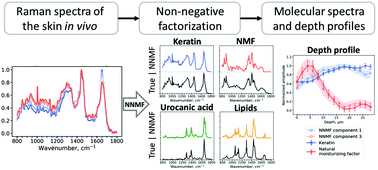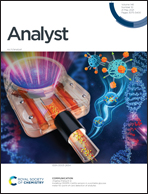Blind source separation of molecular components of the human skin in vivo: non-negative matrix factorization of Raman microspectroscopy data†
Abstract
Determination of the molecular composition of the skin is crucial for numerous tasks in medicine, pharmacology, dermatology and cosmetology. Confocal Raman microspectroscopy is a sensitive method for the evaluation of molecular depth profiles in the skin in vivo. Since the Raman spectra of most of the skin constituents significantly superimpose, a spectral decomposition by a set of predefined library components is usually performed to disentangle their contributions. However, the incorrect choice of the number and type of components or differences between the spectra of the basic components measured in vitro and in vivo can lead to incorrect results of the decomposition procedure. Here, we investigate an alternative data-driven approach based on a non-negative matrix factorization (NNMF) algorithm of depth-resolved Raman spectra of skin that does not require a priori information of spectral data for the analysis. Using the model and experimentally measured depth-resolved Raman spectra of the upper epidermis in vivo, we show that NNMF provides depth profiles of endogenous molecular components and exogenous agents penetrating through the upper epidermis for the spectra and concentration. Moreover, we demonstrate that this approach is capable of providing new information on the molecular profiles of the skin.



 Please wait while we load your content...
Please wait while we load your content...